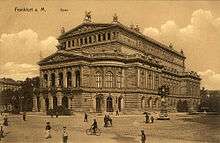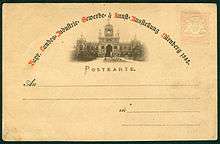Collotype
Collotype is a dichromate-based photographic process invented by Alphonse Poitevin in 1855,[1][2] from which beautiful tonal images can be reproduced without the need for halftone screens.

In Poitevin's process, a lithographic stone was coated with a light sensitive colloid and after thorough drying, exposed to a continuous tone negative. After exposure, the coating was washed under clean, running water and left to dry. The resulting image on the water receptive gel coating would then vary in hardness according to the amount of light that reached it through the negative. The shadow areas were softer and would accept more ink and the highlights harder, accepting little or no ink, with a continuous tone appearance.
The collotype plate is made by coating a plate of glass or metal with a substrate composed of gelatin or other colloid and hardening it. Then it is coated with a thick coat of dichromated gelatin and dried carefully at a controlled temperature (a little over 50° Celsius) so it "reticulates" or breaks up into a finely grained pattern when washed later in approximately 16 °C water. The plate is then exposed in contact with the negative using an ultraviolet (UV) source which changes the ability of the exposed gelatin to absorb water later. The plate is developed by carefully washing out the dichromate salt and dried without heat. The plate is left in a cool dry place to cure for 24 hours before using it to print.
The collotype printing process did not achieve commercial viability until Joseph Albert invented the first mechanized collotype press in 1868. Short runs can printed on a proofing press, but longer print runs are carried out on a flatbed machine, where the plate is made square, level and fixed on the bed. The plate is then dampened with a slightly acidic glycerine–water mixture which is selectively absorbed by the different gel hardnesses, blotted before inking with collotype ink using a leather nap or velvet rollers. Best results are achieved with hard finished paper such as Bristol, placed upon the plate and covered with a tympan before slight pressure is applied. The collotype process uses much less pressure than other types of printing, such as lithography, letterpress or intaglio. While it is possible to print by hand using a roller or brayer, the best consistency in pressure and even distribution of ink is most effectively achieved on a mechanized press.
The collotype printing process was used for volume mechanical printing before the introduction of simpler and cheaper offset lithography. It can produce results difficult to distinguish from metal-based photographic prints because of its microscopically fine reticulations which compose the image. Many old postcards are collotypes. Its possibilities for fine art photography were first employed in the United States by Alfred Stieglitz.
Because of its ability to print fine detail, it was also used for business cards and invitations with fine script lettering.
Historical Background
Collotype originates front the Greek word kola for glue. It was invented in 1855 and the process was shown in 1859 by F. Joubert. Poitevin patented the idea of collotype printing the same year it was invented in 1855. In 1868 Joseph Albert and Jakub Hasnik developed some important components to the collotype process. The prints would only work with 100 prints or less because of an issue with the adhesive sticking to copper substrate. Albert and Hasnik found a solution that allowed the problem to be resolved allowing prints up to 1000 instead of 100. Even though the process was efficient, it took a handful amount of time. In order to combat the problem, the gelatin layer was replaced with cellophane foil. The number of facilities that still use collotype printing process include only a few since 2010. [3]
References
- "The Poitevin Patents and the Importance of Using Primary Sources". BrevetsPhotographiques.fr. Archived from the original on 2013-02-13.
- Jones, Bernard Edward. Cassell's cyclopaedia of photography. Ayer Publishing.
- Stulik, Dusan (June 9, 2020). "COLLOTYPE" (PDF). Getty.edu. Retrieved June 9, 2020.
Further reading
- Dusan C. Stulik, Art Kaplan, Collotype. Getty Conservation Institute, 2013 (Atlas of Analytical Signatures of Photographic Processes)
